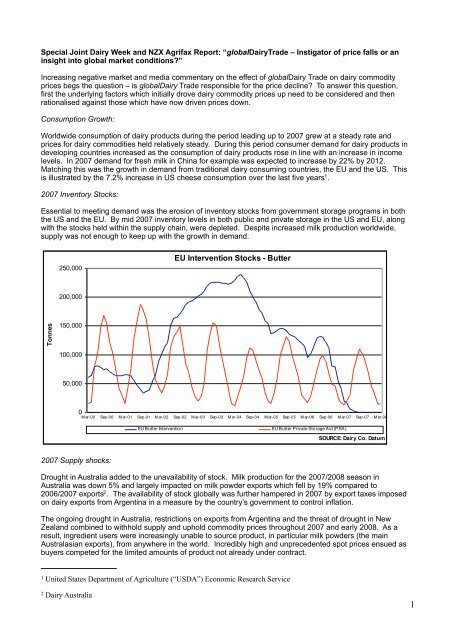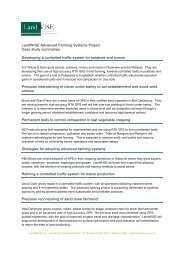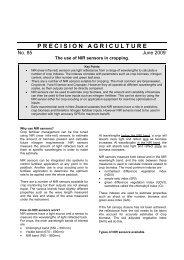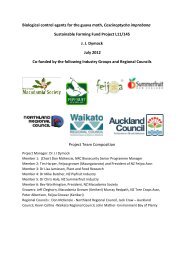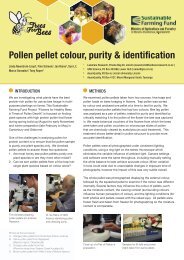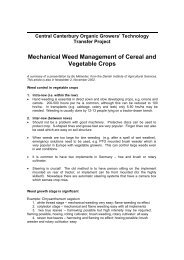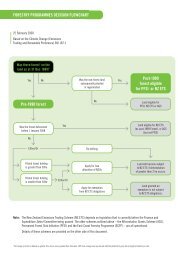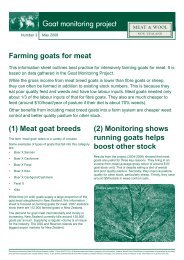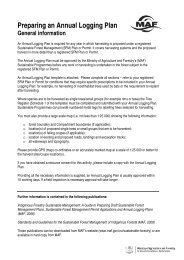Create successful ePaper yourself
Turn your PDF publications into a flip-book with our unique Google optimized e-Paper software.
Special Joint Dairy Week and <strong>NZX</strong> <strong>Agrifax</strong> Report: “globalDairyTrade – Instigator of price falls or an<br />
insight into global market conditions?”<br />
Increasing negative market and media commentary on the effect of globalDairy Trade on dairy commodity<br />
prices begs the question – is globalDairy Trade responsible for the price decline? To answer this question,<br />
first the underlying factors which initially drove dairy commodity prices up need to be considered and then<br />
rationalised against those which have now driven prices down.<br />
Consumption Growth:<br />
Worldwide consumption of dairy products during the period leading up to 2007 grew at a steady rate and<br />
prices for dairy commodities held relatively steady. During this period consumer demand for dairy products in<br />
developing countries increased as the consumption of dairy products rose in line with an increase in income<br />
levels. In 2007 demand for fresh milk in China for example was expected to increase by 22% by 2012.<br />
Matching this was the growth in demand from traditional dairy consuming countries, the EU and the US. This<br />
is illustrated by the 7.2% increase in US cheese consumption over the last five years 1 .<br />
2007 Inventory Stocks:<br />
Essential to meeting demand was the erosion of inventory stocks from government storage programs in both<br />
the US and the EU. By mid 2007 inventory levels in both public and private storage in the US and EU, along<br />
with the stocks held within the supply chain, were depleted. Despite increased milk production worldwide,<br />
supply was not enough to keep up with the growth in demand.<br />
2007 Supply shocks:<br />
Drought in Australia added to the unavailability of stock. Milk production for the 2007/2008 season in<br />
Australia was down 5% and largely impacted on milk powder exports which fell by 19% compared to<br />
2006/2007 exports 2 . The availability of stock globally was further hampered in 2007 by export taxes imposed<br />
on dairy exports from Argentina in a measure by the country’s government to control inflation.<br />
The ongoing drought in Australia, restrictions on exports from Argentina and the threat of drought in New<br />
Zealand combined to withhold supply and uphold commodity prices throughout 2007 and early 2008. As a<br />
result, ingredient users were increasingly unable to source product, in particular milk powders (the main<br />
Australasian exports), from anywhere in the world. Incredibly high and unprecedented spot prices ensued as<br />
buyers competed for the limited amounts of product not already under contract.<br />
1<br />
United States Department of Agriculture (“USDA”) Economic Research Service<br />
2<br />
Dairy Australia<br />
1
Increased Domestic Supply in New Zealand:<br />
By the end of 2007 worldwide supply began to respond to the higher prices. In New Zealand, farmers<br />
stepped up the use of additional supplementary feed (which was viable given the higher returns) to increase<br />
individual cow productivity levels. The numbers of cows in-milk also increased as poorer quality cows which<br />
in leaner return seasons would normally be culled, were retained. The graph below outlines the increase in<br />
cow and land prices between July 2007 and the end of 2008. Cow numbers in New Zealand are predicted to<br />
have increased by approximately 200,000 cows up to the end of 2008 3 .<br />
3<br />
Dairy Australia<br />
2
Dairying land also reached record prices during this time as significant tracts of land were converted to<br />
dairying. In October 2008 the average land price peaked at NZ$52 per kg of milk solids 4 . It is rumoured that<br />
land prices reached as high as NZ$74 per kg of milk solid in key dairy regions.<br />
Increased supply and global demand for dairy products also resulted in a number of new dairy processing<br />
plants being commissioned both in New Zealand as well as internationally. Between 2006 and 2008, six new<br />
processing plants where opened in New Zealand, all focused on producing whole milk powder (“WMP”).<br />
Five of these new processing plants had production coming on line in 2008 5 .<br />
Increased Domestic Supply in Developing Countries:<br />
Domestic milk production in countries such as China also increased. From 2003 to 2007 China recorded a<br />
77% increase in milk production. Factors such as improved technology and lower input, land and compliance<br />
costs than those faced by farmers in developed countries, enabled farmers in these countries to produce<br />
dairy products cheaper than imported product.<br />
Increased Domestic Supply in EU and US:<br />
In the EU, milk production in 2007 increased by 2% as milk quotas increased as part of the EU Common<br />
Agricultural Policy review and in response to higher milk price signals linked to the high international<br />
commodity prices. Increased milk production was again seen in 2008 resulting in a 20% increase in the EU’s<br />
WMP exports. After EU inventory stocks were exhausted, increased milk production was expected to be<br />
absorbed by the domestic market, particularly by new EU member states where incomes where increasing.<br />
Increased milk production was also seen in the US which increased its milk production by 3% in the first half<br />
of 2008 (on 2007 figures) 6 . Traditionally the US has required an annual 1.5% increase in milk production to<br />
keep pace with the domestic growth in demand for dairy products.<br />
Weakened Demand:<br />
By the end of 2007, the high dairy commodity prices had flowed through to end users. During the first half of<br />
2008 prices held steady as wholesalers built up product levels to avoid being caught short again as they were<br />
in 2007. However, this period also saw consumer demand start to weaken. High commodity prices resulted<br />
in increased retail prices. In New Zealand, a 1 kg block of cheese increased from NZ$6.98 in January 2005<br />
to peak at NZ$11.19 in September 2008 7 . Ingredient producers and consumers adjusted their purchasing,<br />
processing and consumption patterns accordingly. Some product substitution to non-dairy products such as<br />
soya occurred, or smaller quantities of product were purchased and/or processing was amended (for example<br />
powder products were diluted further).<br />
US Government Intervention Stocks:<br />
By October 2008 US skimmed milk powder (“SMP”) prices triggered the recommencement of the US<br />
governments’ intervention program. According to The New York Times 8 the US Agricultural Department has<br />
committed to buying 111.6 million pounds of milk powder from US farmers at US$0.80 a pound.<br />
Approximately 61,000 tonnes of SMP was placed into the storage program over the past three months and<br />
around 150,000 tonnes of SMP is predicted to be stored in 2009 9 . The US government last intervened and<br />
bought milk powder for storage in June 2006.<br />
EU Government Intervention Stocks:<br />
At the same time, EU SMP prices decreased to below the intervention price (US$2,325 per tonne). However,<br />
the EU scheme is designed to soak up excess product produced during the northern hemisphere summer,<br />
4<br />
Real Estate Institute of New Zealand, Press Release, 16 January 2008. Note: average price includes Fonterra Fair Value<br />
Shares<br />
5<br />
USDA FAS, “New Zealand Dairy and Products Annual Dairy Industry Report 2008”, 20 October 2008<br />
6<br />
USDA<br />
7<br />
Statistics New Zealand Food Index<br />
8<br />
“As Recession Deepens, So Does Milk Surplus”, The New York Times, Andrew Martin, 1 January 2009<br />
9<br />
USDA World Agricultural Supply and Demand Estimates, 12 January 2009<br />
3
and despite the trigger price level being reached, product will not enter the EU storage program until it opens<br />
in March 2009. No product is currently held in the formal intervention programs, but from March 2009 the<br />
purchase of up to 30,000 tonnes of butter and 109,000 tonnes of SMP at the intervention prices of US$3,820<br />
and US$2,325 per tonne respectively will recommence 10 .<br />
In 2008 160,000 tonnes of EU produced butter was put into Private Storage Aid (“PSA”) and then released<br />
back into the market from mid August onwards, further contributing to the fall in market prices. In an attempt<br />
to support EU domestic butter prices PSA opened on 1 January 2009, two months earlier than usual.<br />
Economic Slow Down In Growth Markets:<br />
By late 2008 it was evident to market participants that supply was exceeding demand and the expected<br />
retraction of dairy commodity prices commenced. The collapse of the US market and the ripple on effect of<br />
the global recession added fuel to the price decline. As stated by DBS Bank Limited in its Daily Breakfast<br />
Spread: “the support for commodity prices has dissipated and the drag from the depressed global demand is<br />
beginning to show.” 11<br />
Asian economies also suffered in 2008 with Bloomberg <strong>report</strong>ing that “the MSCI’s Asian gauge plunged by a<br />
record 43 percent last year as the world’s biggest economies slipped into recession 12 . Importantly for New<br />
Zealand, the Asian markets are key import markets for New Zealand produced milk powder. Malaysia and<br />
Indonesia are New Zealand’s second and third largest import markets for WMP, while the Philippines,<br />
Malaysia, Thailand and Singapore were New Zealand’s largest SMP import markets in 2008.<br />
Singapore, New Zealand’s fourth largest market for SMP, is expected to have a negative GDP in 2009. This is<br />
a significant fall on the 7.3% to 9.0% growth in GDP recorded in the period for 2004 to 2007 and also the<br />
4.5% growth in GDP predicted for 2009 by the International Monetary Fund (“IMF”) back in August 2008.<br />
Singapore’s economy has contracted by a massive 12% (on a seasonally adjusted, annualised basis) during<br />
Q4 of 2008, indicating just how hard the Asian economies, have been hit. Malaysia, New Zealand’s second<br />
largest market for milk powders (following Venezuela), is dependent on palm oil and rubber exports. As<br />
shown in the graph below palm oil and rubber prices have fallen significantly in the second half of 2008.<br />
GDP for Malaysia in 2009 is expected to fall to 3.3%<br />
World Commodity Price Decline:<br />
In mid 2008 the price of many leading world commodities peaked, generally at levels higher in relative terms<br />
than WMP’s peak price at this time. The increased uncertainty caused by the credit crisis in the second half<br />
of 2008 decreased demand, and prices for these leading commodities, including WMP, fell away sharply. In<br />
relative terms and as shown in the graph below, WMP prices have shown much less volatility than all other<br />
leading commodities.<br />
10<br />
USDA FAS, Diary : World Markets and Trade, December 2008<br />
11<br />
“Daily Breakfast Spread”, DBS Group Research, DSB Bank Limited, 5 January 2009<br />
12<br />
Bloomberg “Asian Stocks Advance on Policy Optimism; Toyota Motor Falls<br />
4
The Baltic Dry Index (“BDI”), which measures the cost of transportation of goods via ship, is influenced by<br />
supply and demand for hard commodities such as grain and iron ore. The BDI is considered a leading<br />
economic indicator of future economic growth and production. As can be seen on the graph above the fall in<br />
the BDI has been extreme over the past six months, with the Index moving from a record high on 20 May<br />
2008 of 11,793 to lose over 90% of its value in the 6 months to December 2008.<br />
Ongoing Demand Decrease:<br />
In the current economic climate the often used statement that because people have to eat, demand for<br />
products such as dairy commodities are largely unaffected has shown to be largely untrue. While dairy<br />
commodities have not been affected to the extent that consumer goods markets such as the automobile<br />
industry have, there has been a strong fall off in demand. Rabobank International managing director of food<br />
and agribusiness research, Deborah Perkins is quoted in The New York Times 13 saying “In some of these<br />
countries where dairy hasn’t been a big part of their diet, this is where we are seeing people pull back.”<br />
Falling income levels of the middle class in developing markets such as China where per person dairy<br />
consumption nearly doubled over the past five years, has rapidly retracted the demand for dairy products.<br />
These consumers can still remember what they ate before they were able to afford dairy products and are<br />
able to revert back to their traditional food sources. Developed markets have also been hit hard, with pizza<br />
chains spreading the cheese a little thinner and consumers buying smaller portions of product.<br />
Key Import Markets:<br />
Markets such as Russia (New Zealand’s fourth largest dairy export market), Venezuela, Nigeria and Algeria<br />
which are heavily dependent on imported dairy products have traditionally purchased surplus product, limiting<br />
the excess volume available on the world market. Accepted as potentially vulnerable markets, political and<br />
economic upheaval has in the past resulted in these markets being shut down to imports at various times.<br />
The nature of the current economic crisis is so widespread that these key import markets have all reduced if<br />
not closed their imports at the same time forcing more production onto the world market.<br />
Many of these important dairy import markets are dependent on oil exports. Importantly for New Zealand,<br />
these countries have been traditional importers of its dairy products. Venezuela, Saudi Arabia, Algeria and<br />
Nigeria - all major oil producing nations - traditionally purchase 30% of New Zealand’s WMP production.<br />
From August to October 2008 there was a significant reduction or halt in the volume of New Zealand product<br />
exported to each of these countries. Venezuela, New Zealand’s largest export destination for WMP, has<br />
13<br />
“As Recession Deepens, So Does Milk Surplus”, The New York Times, Andrew Martin, 1January 2009<br />
5
historically purchased between 5,000 and 13,000 tonnes of WMP per month. In August 2008, Venezuela<br />
purchased no product from New Zealand 14 .<br />
Buyer Reluctance:<br />
With short-term credit sources drying up and concerns about the global recession deepening, some importers<br />
face difficulties financing purchases while other wholesalers face having stores of product purchased at levels<br />
substantially higher than current market prices. With consumer demand falling, some wholesalers have faced<br />
difficulties on-selling product. Unsurprisingly, wholesalers, nervous about the rapidly retreating prices and<br />
aware of increased milk supply available during the southern hemisphere production peak in October, have<br />
held off buying stock or have only bought in small quantities to cover short-term obligations.<br />
US and EU Production and Subsidised Exports:<br />
As consumption levels for products such as cheese have fallen away in the US and the EU, more milk<br />
production in these regions is converted into less perishable products such as SMP and butter (which can be<br />
stored frozen). An increased supply of SMP and butter is expected to hit the already oversupplied world<br />
markets in the short-term or when the product is released from storage programs.<br />
At the time of writing this article, the EU announced the reintroduction of export subsidies for dairy products,<br />
aimed at propping up EU dairy producers. World dairy commodity prices are expected to suffer as a result of<br />
this action. There is further downside risk that the US will retaliate, and also reintroduce export subsidies.<br />
Phil York the economic and commerce spokesperson for New Zealand’s Federated Farmers “sees no bigger<br />
man-made threat to the economic well being of all New Zealanders than the risk posed by neoprotectionism<br />
15 ”. As the recession deepens, the EU and the US will protect their own markets at the expense<br />
of world markets. Tom Suber, president of the US Dairy Export Council stated that the reintroduction of EU<br />
dairy subsidies would run the risk of “prolonging the down cycle in which the world’s dairy industry currently<br />
finds itself and significantly delaying natural market recovery 16 ”.<br />
Break Away Selling Method:<br />
GlobalDairyTrade (“gDT”), established in July 2008, is a break from Fonterra’s traditional selling methods. A<br />
limited volume (25%) of Fonterra’s total WMP marketed is sold via the monthly auction. The majority of<br />
Fonterra’s dairy commodity sales are still carried out via direct and closed negotiations with buyers as only<br />
product of certain specifications is available via gDT. The importance of face to face contact with customers<br />
remains for Fonterra as it does for other dairy companies such as Westland Milk Products Limited who pride<br />
themselves on their ability to meet individual client requirements.<br />
Price Falls:<br />
The final average auction prices over the past seven months have followed the failing confidence in the world<br />
economy and have dropped from US$4,395 per tonne to US$2,017 per tonne at the January 2009 auction.<br />
During the same period of time the average WMP commodity prices recorded by us have fallen from US<br />
$4,300 17 to US$1,850 18 . gDT recorded a fall of 14% in early September as the economic crisis unfolded and<br />
increased nervousness was evident in the market. From October the fall in WMP price has mirrored spot<br />
market prices 19 and in the weeks that the gDT auctions have taken place the auction price has matched the<br />
WMP price fall recorded in the preceding weeks 20 .<br />
14<br />
Statistics New Zealand<br />
15<br />
“Return of EU Subsidies “Neo-Protectionism”, Scoop, Federated Farmers Release, 20 January 2009<br />
16<br />
Dairy Globe, 19 January 2009<br />
17<br />
<strong>NZX</strong> <strong>Agrifax</strong> Monthly Dairy Report, July 2008<br />
18<br />
<strong>NZX</strong> <strong>Agrifax</strong> Weekly Dairy Report, 9 January 2008<br />
19<br />
As collected by <strong>NZX</strong> <strong>Agrifax</strong> from market participants<br />
20<br />
Ibid<br />
6
Transparency:<br />
The benefit of the auction system is the transparency it provides of where the WMP market is currently sitting.<br />
In a downwards moving market this is advantageous to the buyer and in an upwards market, assists the<br />
seller. This also provides buyers with an additional tool when negotiating purchases outside of the auction<br />
process. Market participants have always been able to discover the current prices for dairy commodities with<br />
a little market research or a subscription to a research service. The difference with the gDT system is that<br />
pricing data is publically available on its website immediately following the monthly auctions. The final gDT<br />
auction price sets a market reference price for all sales of WMP. This reference price and the availability of it,<br />
eliminates any short-term window to sell product at inflated prices to the final auction price. Unfortunately,<br />
what gDT lacks is information on the market factors driving the WMP auction price. A lack of information<br />
leaves the reader of gDT’s data to make their own conclusions on the reasons behind the price movements.<br />
Conclusion:<br />
The rapid rise in dairy commodity prices during in 2007 occurred due to continued growth in demand<br />
outstripping supply levels. Demand for dairy products rose in line with increased income levels of the middle<br />
class in developing countries and consumers in developed countries increasingly living beyond their means.<br />
The dramatic decline in demand for dairy products over the past six months is the culprit behind the sharp<br />
decline in commodity prices. The decrease in demand was originally stimulated by resistance to the high<br />
dairy prices, but has been spectacularly fuelled by the global economic crisis. Increasing supply levels in<br />
particular from the EU and US have helped create a perfect storm and have made the recent fall in dairy<br />
commodity prices inevitable. The gDT auction price provides the market with an insight into how the dairy<br />
markets have been tracking and the direction they will take in the future. To blame gDT for the fall in dairy<br />
commodity prices is to ignore the substantial and unprecedented global market factors affecting commodities<br />
worldwide.<br />
Back in September 2008 21 we predicted that the existing market factors meant that demand for dairy<br />
commodities would be unlikely to pick up until late 2009. The reintroduction of EU subsidies, and the<br />
possibility that the US will follow suit, will distort an already depressed world market and have the significant<br />
potential to delay any upturn in dairy commodity prices further. The current global recession has largely<br />
dictated the demise of consumer demand for dairy commodities. A positive and sustained return of consumer<br />
demand is essential to returning dairy commodity prices to levels which are viable and sustainable from a<br />
production point of view. With the reintroduction of subsidies and many predicting that the depths of the<br />
global recession have yet to be reached, it may be well into 2010 before there is any positive pricing news for<br />
dairy commodities.<br />
21<br />
<strong>NZX</strong> <strong>Agrifax</strong> Monthly Dairy Report, September 2008<br />
7


